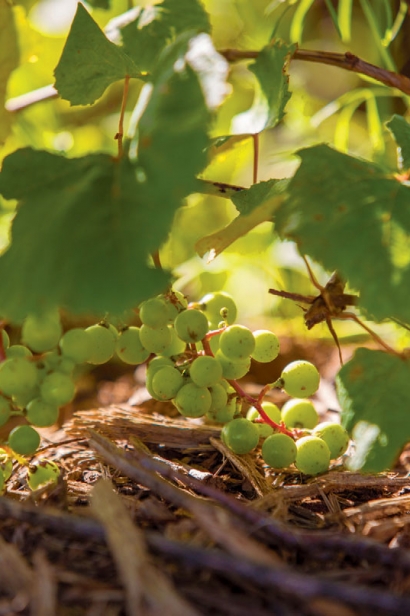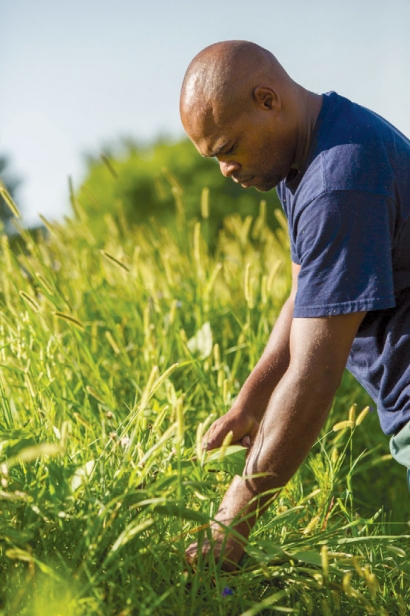A Roadside Attraction
A Community Tries a Hand at Food Forestry Along the Tisdale Highway
Imagine a forest: a wild swath of land, thick with trees and underbrush, alive with insects and woodland creatures. Origins unknown, it was not planted by hand, nor is it cared for by man, yet it thrives, year after year. When you imagine a forest you might not picture a roadside agricultural experiment but that is exactly what you’ll find lining the L. L. Tisdale Parkway just north of downtown Tulsa: a food forest with a story.
Growing up in Wisconsin, Mark Shepard spent long, hot summer days toiling in his family’s sprawling vegetable garden. It was hard, dirty work that he didn’t particularly enjoy. He preferred hauling firewood, a physically demanding chore but one that could be accomplished under the shade of the woods with snacks of wild nuts and berries provided by the forest free of charge. Shepard wondered:
“Why was it that growing our garden produce was so much work, and yet out here in the woods … there was so much to eat, and we did nothing but harvest the bounty?”
Perhaps it was a touch of sloth that initially drove him to question modern reliance on annual agriculture but it was this line of inquiry that led him to his life’s work. He is now the proprietor of New Forest Farm, a 106-acre commercial-scale perennial agricultural ecosystem, and author of Restoration Agriculture: Real World Permaculture for Farmers. In his book, Shepard extolls the many virtues of agro-forestry: minimal maintenance, enhanced habitat for pollinators and wildlife, elimination of pesticides (since there is a predator for each pest in the functioning ecosystem) and increased resilience against catastrophe.
When Tulsa native Nathan Pickard finished reading Restoration Agriculture last fall, he was inspired. No stranger to urban gardening, Pickard helped start the Brady Heights community garden many years ago, later embellishing the garden with fruit trees and blackberry bushes before turning his efforts to his own backyard. But reading Shepard’s critique of annual agriculture got him thinking it was time to purchase acreage and plant his own demonstration food forest. His property search took him to North Tulsa but as he drove home one day he noticed the abundance of vacant land lining the L. L. Tisdale Parkway. It gave him an idea: Why not use the highway right of way, unused land that requires costly maintenance by the city, for a food forest?
Pickard pulled together a team, starting with Up With Trees board member E. J. Oppenheimer, who Pickard was surprised to learn works closely with Shepard on agroforestry projects around the world. With support from Up With Trees and Green Country Permaculture’s James Spicer, as well as a diverse set of volunteers ranging from a nutritionist to a sound engineer, the team created a site plan and a proposal guided by a simple goal: “Create an orchard which creates value.”
By the end of April the team was ready to plant. With a generous donation from the local nonprofit Transitions Tulsa, as well as a smaller donation from a shuttered Wal-Mart, 500 trees and shrubs were purchased for the forest including Chinese chestnuts, pecan, plum, peach, fig, cherry, mulberry, apple, jujubes, Virginia pine, black locust and loblolly pine trees. Over the course of two weeks, with design guidance from Green Country Permaculture, equipment from E. J. and Luke Oppenheimer’s Valley Park Ranch, and plenty of volunteers, three rows of fledgling forest were stretched along six city blocks of highway. Though planting the forest was a labor-intensive process, strategic permaculture design makes it a low maintenance project with far greater outputs than inputs over time. James Spicer estimates that in three to five years, once the trees and shrubs begin producing, the forest will yield thousands of pounds of food each season.
Not just any food but healthy, high-demand market crops. Crops that will be cared for and harvested by North Tulsa teenagers, hired through the nonprofit Crossover Community Impact. Crops which can be sold competitively at markets and through mobile grocers, bringing new fresh fruit and nut options to food deserts. In addition to the literal fruits of labor, the forest will provide beautification, shade, habitat, biodiversity, jobs, noise reduction, pollution reduction and decrease the mowing footprint.
To the untrained eye the forest looks like a tangled mess of wildflowers, blackberry bushes and a variety of saplings. There is a method to the madness, however. Native wildflowers serve to attract pollinators, which will increase fruit production. Daikon radishes will send big tubes into the ground, breaking up the soil so it can better absorb water, while black locusts will fix nitrogen for the trees.
“We planted a large diversity and we spaced them pretty close so that way as trees do die other ones will fill in. It’s, like, let’s throw a bunch of diversity out here and then this site is going to give us feedback, it’s going to let us know what’s working and what’s not,” Spicer explains.
This laissez faire approach might seem counterintuitive to a farmer, or even gardener, who is accustomed to nursing their plants through thick and thin. No one likes to see a plant die after they’ve labored over it. Oppenheimer describes the method this way: “You don’t want a tree that’s like a prima donna that you have to take care of and water and is bothered by pests. You want a tree that’s, like, ‘No, I’m here to grow and this is my spot and just leave me alone and I’ll be fine.’”
The hope is that the forest will fill in and flourish over time. That it will grow tall and stand on its own. That it will outlive us all and that those who come after us will enjoy a legacy of fresh fruit, nuts and berries. Future generations might observe, appreciate and replicate the thoughtful design of the Tisdale Food Forest. They might forage a free snack in the shade of the forest and wonder, where did this all come from?
For more information find the Tisdale Food Forest at Facebook.com/tisdalefoodforest.








